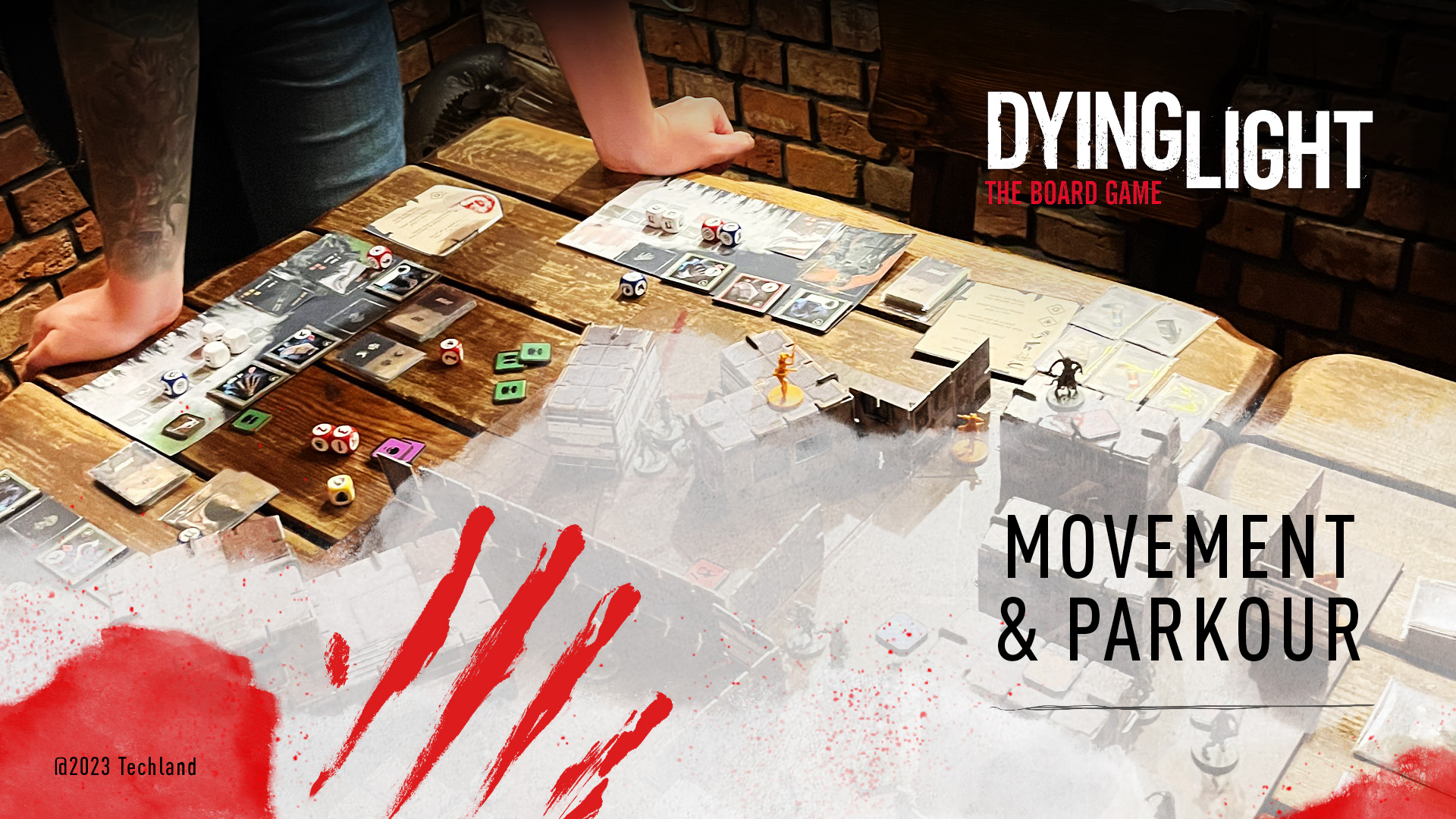
Do not go gentle into that good night
Greetings, Survivors!
Today’s spotlight is special, as it’s actually about yourselves! To be more precise, we wish to show you the manner in which the player characters—the Runners—operate in Dying Light: The Board Game. Last time, we told you about the difference between Day and Night turns and the way the game world changes after dark. The next natural step is therefore to tell you how the Survivors deal with the unfavorable conditions inflicted upon them as they progress through each Scenario.
CAMERA, DICE, ACTION!
Each character has a pool of Action dice—basic and specialized. Each one of them allows the player to perform basic actions. On top of that, the basic dice can increase your chances to avoid opponents while moving and Defend yourself in combat. The Parkour specialization die provides the player characters with a significant advantage when jumping and climbing. The Combat specialization die, on the other hand, allows them to improve their defense, push away enemies, and strengthen weapon attacks.

At the beginning of their activation, each player rolls their dice pool. Each result (with symbols on the dice, called Boosters) can be used to enhance their actions. The system is designed in such a way that each action die (regardless of its type) enables the player to perform one of five basic actions:
- Run
- Climb
- Jump
- Fight
- Use/Interact
This ensures that the player is always able to act, no matter the result of their roll. Adding to this the option to use the proper Booster, they can enhance a given action and combine the dice in order to pull off some spectacular stunts.
KEEP UP THE TEMPO AND DON’T FAINT!
To make it easier for the players to manage their actions, we designed the Momentum Track, on which they place spent Action dice.
In Dying Light, maintaining momentum is a crucial factor. It is gained as the player characters move and perform parkour maneuvers. On the other hand, there is the active Stamina system, which temporarily limits their exploits. Our intention was to capture both of these dependencies and it was to this purpose that we mapped them onto the Momentum Track, interconnecting them with player actions.

The spent Action dice are arranged in order from left to right. The 4th slot on the Track is yellow, symbolizing the Momentum gain. Once it is reached, the player receives an active Momentum token, which from then on can be turned to their advantage.
Still, they must be careful! If they take damage or stop moving, they lose their Momentum and the bonuses connected to it. This way, we reward characters who are active and bold, at the same time bringing into play an element of risk management.
Should you make use of your Momentum at the first opportunity, or try to save it, perhaps even until the next turn, at the risk of being attacked in the Exposure phase and losing it?
Let’s add that specific Abilities gain an additional power-up effect when used with active Momentum, while certain weapons reward hitting “in tempo” with extra damage, and the whole system starts to click into place!
You will notice that the last two spaces on the Momentum Track are highlighted in red. These are Fatigue fields. If a player resolves an effect that involves the application of Fatigue, they move their most recent Action die to the Fatigue slot. During their next activation, when they collect all their dice to roll for their actions, they cannot take and use the ones from those slots—they receive them only in the subsequent turn.
This way, we introduce the opportunity to use weapons and skills in a different, non-standard way (including empowered attacks and desperate actions), at the same emphasizing the player’s limitations and Stamina management.
Of course, if you played the digital version, you are certainly aware of stamina and endurance boosters along with other consumable items. These also have their place in our game and can be used to cross the line and exceed a character’s physical limitations, enabling them to win the day with an exceptionally spectacular stunt!
CHOOSE YOUR PATH
Once you begin to feel the flow and want to carry out increasingly impressive tricks and combos, the progression system allows you to improve your basic dice. Will you go Combat, Parkour, or Hybrid? By choosing to upgrade your dice, you won’t lose any of your mobility and dynamics (both types of dice reinforce each other and allow you to perform standard actions as per normal).
If you combine this with a selection of skills (from a skill tree also divided into Combat and Parkour) and snap up some crafty equipment, you’ll be sure to have a blast, regardless of whether you love bloody mayhem or ninja-style parkour!
This covers the outline of the actions system. Its simplicity and ease of use grant the players endless possibilities for dynamic combinations and allows them to use the terrain to their advantage. But don’t think we’ve stopped there! Look out for future posts where we will introduce you to the movement-related Risk system and some neat crafting options for customizing your weapons.
FEAR OF THE DARK
The last core part of a Runner is their personal Exposure deck. It is used by the player to draw cards during the Exposure phase, depending on the number of actions they’ve performed in their last activation. Subsequently, the Infected react according to a simple algorithm based around the symbols on the revealed cards.
Exposure cards, just like ourselves, are of a dual nature, with their effects divided according to the Day and Night dichotomy, generating danger for the players, depending on the time of day in which they act.

At the beginning of the game, each character has the same Exposure deck consisting of cards with simple Move/Attack/Spawn symbols. However, each of us has their own phobias and reacts slightly differently to stressful situations. Likewise, each Runner is a unique character, shaping their own fate and history, which is why each of the players possesses their own, unique card, the so-called Final Resolve, which triggers additional effects depending on the situation in which it is pulled. As the players progress through Scenarios and Campaigns, they modify their Exposure deck, reflecting acquired Traumas and other meaningful experiences.
Perhaps one player character reacts with panic after having been chased by a pack of Virals through the subway, but feels very comfortable dealing with them out in the open? Maybe another acts on a past grudge to mercilessly wipe out a group of bandits, but can barely stand up to people during the night? These types of advantages and disadvantages are stored in the player’s Exposure deck, to appear when they least expect them (or maybe just in time to save you from certain death!).
Exposure decks also support the Chase mechanic, which will be the topic of a future post also describing the special types of Infected and their impact on a Scenario.
Take the Action dice, the Momentum Track, Risk management, Combat & Parkour-focused Skills, fancy Gear, Crafty Equipment, and—on top of it all—the personal Exposure Deck, and you’ve got your Runner! This is how we envision a dynamic and open-ended system to provide you with interesting choices alongside tons of fun and juicy gameplay.
Remember to let us know what you think!
We’re especially curious about your feelings toward the Immunity system present in the digital game. In case you need a refresher: whenever you are not exposed to sunlight or UV, you only have a certain amount of time until you turn into one of the Infected. Do you like this kind of pressure and do you think it works well in board games? Should the Immunity system allow for the player to turn into a monster (thus killing off their character)? Or maybe there should be some kind of option for a “comeback”, more akin to movies and TV shows?
Be sure to take your feedback to our official Facebook group for Dying Light: The Board Game.
Stay Fresh & Stay Human!



